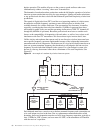
Chapter 6 - Introduction to Wireless Intercom Systems 89
The answer to the frequency problem is to utilize a digitally synthesized, frequency agile
system. That may sound simple enough in theory, but in reality, designing such a product
is a totally different matter. A digitally synthesized, frequency agile system must not only
incorporate a superior design with high-quality filtering to withstand the rigors of an
overcrowded frequency spectrum, but it must also offer an ergonomically designed user
interface that allows ease of frequency selection and operation. End users must experience
the same ease of operation they get from their existing two-wire beltpacks.
To date, the chief limitation to most wireless intercoms (other than finding available
spectrum) has been they are inherently one-channel in nature while the most common
hardwired intercom system from RTS (used in virtually all TV broadcast trucks and
facilities) is two-channel. Two-channel operation allows users to switch easily from one
intercom channel to another. This allows a stage manager, for instance, to communicate
with the producer and then switch over to the director circuit as necessary. Two-channel
operation has become the hardwired industry standard and users who have increasingly
relied on wireless intercoms must be able to employ that technology in wireless form
without having to deal with huge racks full of equipment.
Wireless intercom systems that can operate in high RF environments must not only offer
interference resistant operation, but must utilize design techniques that will not interfere
with other wireless equipment like wireless microphones and IFBs. Another key to a
wireless intercom’s successful operation and coexistence with DTV is its ability to avoid
strong local TV stations, as well as, coordinate multiple system frequencies. This holds
true whether the system is VHF or UHF, fixed-frequency, frequency-agile or synthesized.
Utilizing the minimum power necessary is absolutely critical if wireless intercoms are to
coexist with other low-power wireless equipment. The utilization of intelligent systems
that reduce beltpack transmitter power levels as they get closer to the base station can
greatly decrease the harmful interference that can be associated with wireless
communications gear.
Future wireless intercoms (see Figure 6.3) will need to provide users with frequency
agility, high-end filtering, RF power management, ease of use, two-channel operation,
extended battery life, small lightweight beltpack and a user interface that allows
operational and frequency parameters to be easily set and checked without the use of
external equipment, such as a laptop computer or special interface box.
Figure 6.3
The RadioCom™ BTR-800 System is an outstanding example of the next generation
of wireless intercom systems.
As wireless intercom applications for broadcast professionals continue to grow more
complex and challenging, the need for products that can meet these challenges will also
grow accordingly. All these factors and more, as discussed in this chapter, and in the next
chapter, must be considered when looking at the quality and functionality of a modern
wireless intercom system.


















